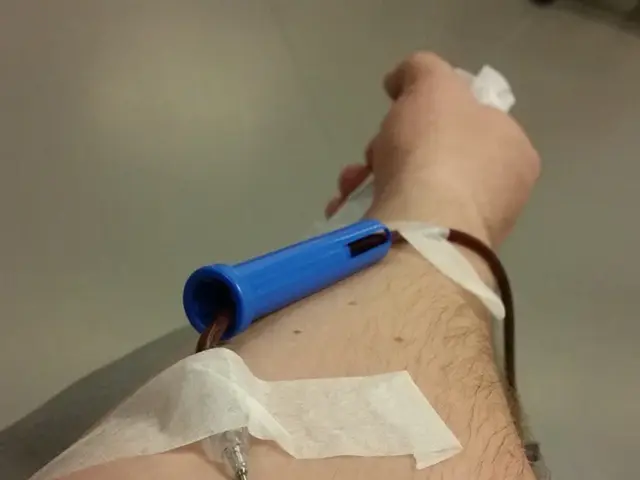Expected progression following hip replacement surgery: Insights on the recuperation period
Hip Replacement Surgery Recovery: A Comprehensive Guide
Recovery from hip replacement surgery varies from individual to individual, but most patients can resume light activities within 3 to 6 weeks post-surgery.
Before undergoing surgery, patients should prepare their bodies for the procedure to minimize complications and hasten recovery. This involves discussing the surgery with their doctor, researching the process, engaging in leg, core, and upper body exercises, maintaining a moderate weight, quitting or reducing smoking, arranging for post-surgery assistance, and cooking meals in advance.
Following surgery, patients may remain in the hospital for 1 to 2 days, although some may go home on the same day. Pain relief medications such as opioids, local anesthetics, NSAIDs, or acetaminophen will be administered by doctors. The incision will be either stapled or stitched closed, requiring wound care at home for approximately 2 weeks.
Physical therapists will instruct patients on how to exercise their legs to strengthen the hip joint, advise them on what activities to avoid, and teach them how to sit and bend to protect the new hip.
Upon returning home, patients may require assistance with daily tasks for several weeks or may need to stay in a rehabilitation facility. Pain and discomfort persist for a few weeks, necessitating continued use of prescription medications. Physical therapy or home exercises recommended by a physical therapist will help speed recovery, improve flexibility, and strengthen the new joint.
By 10 to 14 days post-surgery, stitches will be removed, and pain and swelling may begin to diminish though this may take longer for some patients. By the three-to-six-week mark, most patients can generally resume light activities of daily living, though returning to work may vary depending on the physical demands of the job.
Patients should continue with physical therapy for at least two months after surgery and consult with their doctor about when it is safe to engage in additional exercise like swimming and walking.
Three months post-surgery, patients can usually resume daily activities. However, they should consult with their doctor before discontinuing physical therapy and reducing activity levels.
To aid recovery, patients should adhere to prescribed physical therapy exercises, engage in gentle exercises like walking, use a reclining position, apply cold compresses to reduce swelling, take prescription medications as directed, use walking aids like crutches if necessary, avoid sitting still for prolonged periods, limit intense exercise, and avoid bending the hip more than 90 degrees or moving heavy objects.
Complications during recovery can differ for younger and older adults. Younger individuals, including those under 20 diagnosed with osteonecrosis of the femoral head, can have favorable outcomes with modern hip replacement implants. However, they may be more prone to complications due to preexisting conditions like heart and lung disease, clogged arteries, or high blood pressure.
• follow physical therapy exercises as a physical therapist instructs• try other gentle exercises, such as daily walking• sit in a reclining position• use a cold compress to reduce swelling• take any prescription medications as a doctor instructs• use walking aids, such as crutches, if necessary
Older adults, particularly those already compromised by mobility issues, may experience challenges during recovery. Careful avoidance of falls, using walking aids, and rehabilitation care can help ensure a smooth recovery for this demographic.
In the case of hip resurfacing surgery, patients can expect to remain in the hospital for one to four days. They may begin putting weight on their leg immediately after surgery, although they might require a walking aid for the first few days or weeks. Recovery from hip resurfacing surgery follows a timeline similar to that of traditional hip replacement surgery.
• sitting still for long periods• crossing the legs at the knee• bending the hip more than 90 degrees• bending down to touch the feet or ankles• sitting in low chairs• intense exercise, which may involve jumping or sudden turns• moving or lifting heavy objects
Overall, hip replacement and resurfacing surgeries show similar outcomes and high success rates. By following a structured rehabilitation plan and engaging in physical therapy at home and in the hospital, patients can expect to resume most daily activities within six weeks and regain full recovery within a year.
- Preparation for a hip replacement surgery includes discussions with doctors, researching the process, leg, core, and upper body exercises, maintaining a moderate weight, quitting or reducing smoking, arranging for post-surgery assistance, and cooking meals in advance.
- Patients may remain in the hospital for 1 to 2 days after surgery, though some may go home on the same day.
- Pain relief medications will be administered by doctors, such as opioids, local anesthetics, NSAIDs, or acetaminophen.
- The incision will be either stapled or stitched closed, requiring wound care at home for approximately 2 weeks.
- Physical therapists will instruct patients on how to exercise their legs to strengthen the hip joint.
- Patients may require assistance with daily tasks for several weeks or may need to stay in a rehabilitation facility.
- Pain and discomfort persist for a few weeks, necessitating continued use of prescription medications.
- By 10 to 14 days post-surgery, stitches will be removed, and pain and swelling may begin to diminish.
- By the three-to-six-week mark, most patients can generally resume light activities of daily living.
- Returning to work may vary depending on the physical demands of the job.
- Patients should continue with physical therapy for at least two months after surgery and consult with their doctor about when it is safe to engage in additional exercise.
- Three months post-surgery, patients can usually resume daily activities.
- To aid recovery, patients should adhere to prescribed physical therapy exercises.
- They should also engage in gentle exercises like walking.
- Patients should sit in a reclining position and use a cold compress to reduce swelling.
- They should take prescription medications as directed and use walking aids, such as crutches, if necessary.
- Patients should avoid sitting still for prolonged periods and limit intense exercise.
- They should avoid bending the hip more than 90 degrees or moving heavy objects.
- Younger individuals may be more prone to complications due to preexisting conditions like heart and lung disease, clogged arteries, or high blood pressure.
- Older adults may experience challenges during recovery, particularly those already compromised by mobility issues.
- Careful avoidance of falls, using walking aids, and rehabilitation care can help ensure a smooth recovery for this demographic.
- In the case of hip resurfacing surgery, patients may begin putting weight on their leg immediately after surgery.
- Recovery from hip resurfacing surgery follows a timeline similar to that of traditional hip replacement surgery.
- Complications during recovery can differ for younger and older adults.
- Hip resurfacing surgery can take place over 1 to 4 days.
- Patients recovering from hip replacement or resurfacing surgeries should follow a structured rehabilitation plan.
- By engaging in physical therapy at home and in the hospital, patients can expect to resume most daily activities within six weeks.
- Patients can expect to regain full recovery within a year by following a structured rehabilitation plan and engaging in physical therapy.
- Physical therapies and treatments play a crucial role in helping patients recover from hip replacement surgery.
- Other chronic diseases concerning health and wellness include COPD, Alzheimer's, obesity, and chronic kidney disease.
- Science in various industries, such as medicine, environmental science, and finance, plays a key role in understanding, managing, and preventing chronic diseases.
- Workplace wellness programs and personal finance management are essential for a person's overall health, mental health, and aging – factors that can impact various industries, such as manufacturing, retail, entrepreneurship, and real estate.








